By Bus & Rail
Working on the railroad
April 25, 2013
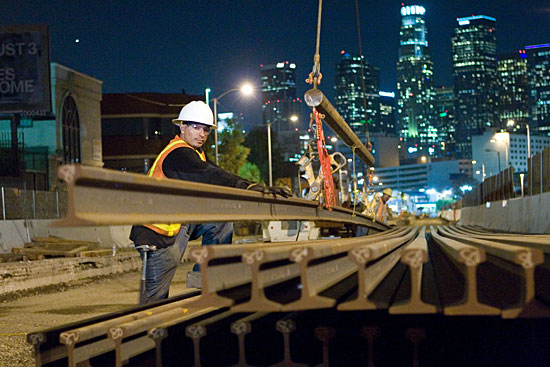
All the new rail Metro is laying means more job opportunities in maintenance and operations. Photo courtesy Metro
With soaring tuition costs and an economy recovering at a glacial pace, it’s a tough time to pursue a career. But Los Angeles County Metropolitan Transportation Authority is in the midst of a vast expansion of its rail network and will need skilled hands to take care of such work as maintenance, inspection and communications.
With that approaching reality in mind, Metro’s Board of Directors on Thursday approved the Rail Technical Training Program, a new collaboration between the transportation agency and Los Angeles Trade Technical College.
“For young people who aren’t interested in a four-year school, this could be an opportunity to get hands-on training and learn something specific to the transportation industry,” said Marion Jane Colston, director of strategic and organizational planning for the agency.
Metro will provide technology and on-the-job expertise while the college adds the academic piece. Together, they hope to create a cutting-edge program to train existing employees and give a new generation of workers the skills they’ll need to land jobs at Metro or other rail operators.
After the program is approved, staff from both sides will develop a standardized curriculum, which will be presented to the California Community Colleges Chancellor’s Office for review. If approved, the college will then be able to offer a new trade certificate and students can apply for financial aid to take the classes.
Leticia Barajas, the trade school’s vice president of instruction, sees great potential in the program.
“Our goal is to become the premier training institution for Metro,” Barajas said. “Students seeking this certification could also get their associates degree and move on further.”
In the future, she added, the school hopes to train students for management positions to give them another path to career advancement.
For Metro, the program is a way to make sure its staff has the best training possible to keep trains moving swiftly and safely, while preparing to meet a looming need for additional skilled workers.
“For every mile we add, we’ll need to increase the staff by a similar proportion,” said Bruce Shelburne, Metro’s executive director for rail operations.
When the projects from the Measure R sales tax are built, the amount of rail will have roughly doubled, so the number of workers will need to double, too.
For Barajas, that sounds like a bright future for her students. “It’s an amazing opportunity to get into high paying jobs with real opportunity for career advancement in the L.A. region.”
Posted 4/25/13
Trying to beat Dodger traffic blues
April 4, 2013
Every spring, it happens like clockwork: Vin Scully’s voice lilts across the metropolis, Dodger dogs become an essential food group and downtown L.A. resigns itself to 80-plus nights of traffic headaches.
This year, though, there’s an upstart rookie in town: a 1.5-mile dedicated Dodger Stadium Express bus lane running along Sunset Boulevard, aiming to revolutionize how the getting-to-the-stadium game is played.
With the Dodgers under new management and the stadium freshly spiffed up with a $100 million renovation, aggressive efforts are underway to crack one of L.A.’s thorniest traffic dilemmas—getting fans into and out of Chavez Ravine when most home games overlap with downtown’s always lively afternoon rush hour.
“There’s no room for error,” said Aram Sahakian of the city Department of Transportation’s special traffic operations division. For the home opener Monday, “we threw everything we had at it.”
It paid off on the first day, he said: “I don’t think ever in Dodgers history we’ve cleared [stadium traffic from] Sunset on Opening Day before the first pitch…It was a huge success.”
But while ridership on the Dodger Stadium Express buses is up—9,750 so far this year, compared to 7,157 at the same time last year—general traffic downtown this week has been, well, foul.
“Obviously, when you take a lane away, it will have an impact,” Sahakian said, “but it’s also driver behavior. There’s some tweaking to be done.”
The new lane on Sunset, while a boon to game-goers who ride the express buses, is clearly confounding some drivers.
“It’s new to motorists; they don’t know what it is,” Sahakian said of the dedicated lane, which begins at Figueroa and runs through Elysian Park to the stadium.
Those used to driving in the curbside space now taken up by the new, 12-foot-wide bus lane will need to adjust by changing their lane choice, or their route, he said. And those headed to the game by car should give some serious thought to taking the bus next time. (The buses depart from Union Station at 10-minute intervals before each game, and every 30 minutes while the game is in progress.)
Other adjustments also are in the works. Sahakian is proposing that the city’s Automated Traffic Surveillance and Control system be up and running for all home games, as it was on Opening Day, so real-time adjustments can be made to traffic signals. Sahakian also is suggesting that cars carrying four or more people be allowed to use the special lane.
“We’re brainstorming,” he said. “It’s a challenge. The venue, the location, is a challenge for us.”
This year, enthusiasm about the team and its new owners means likely higher attendance, with 20 games already sold out, Sahakian said. And that means heavier traffic.
“We know attendance is going to be very high. We’re excited about it, but with that comes challenges.”
Renata Simril, the Dodgers’ senior vice president for external affairs, said the organization is heavily promoting Dodger Express bus ridership and the new dedicated lane, including on Scully’s popular broadcasts.
She said the Dodgers have also made adjustments to make it quicker for motorists to get into the stadium parking lots. “Ambassadors” now walk down lines of waiting cars to accept parking payment. (They’re still accepting cash only, but by next season should be equipped with mobile devices that will allow them to take credit cards.)
In addition, the ballpark is opening half an hour earlier before games—at 4:30 p.m. for a 7:10 p.m. start.
“Every little bit helps,” Simril said. “We’re trying to take a multi-pronged approach.”
The Dodger Express buses, which are free to riders with a game ticket and $1.50 each way for other passengers, run on clean-burning compressed natural gas and are funded by a two-year, $1.1 million grant from a regional air pollution reduction committee.
City officials and the Dodgers are hoping that increasing express bus ridership will reduce the number of cars coming into the stadium, and the dedicated lane on Sunset is seen as an important tool in persuading people to hop aboard.
“Taking one lane away is going to impact people driving to the stadium,” Sahakian acknowledged, “but at the same time, you’re incentivizing mass transit.”
Looking at the long-term picture, though, Sahakian thinks a bolder solution may be called for.
“My personal recommendation,” he said, “would be a monorail.”
Posted 4/4/13
Making new connections in the Valley
March 14, 2013
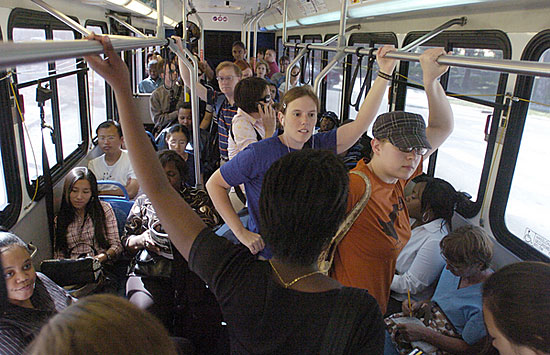
There’s a new ride coming to the Valley—either a light rail or rapid busway. Now’s your chance to weigh in.
First came the Orange Line, a dedicated busway in the San Fernando Valley that gives folks from Woodland Hills to North Hollywood a speedy alternative to local bus lines or traffic on the 101. Ridership on the line continues to surge, and an extension to Chatsworth opened last June.
Now the focus shifts eastward. The East San Fernando Valley Corridor project, to be routed along Van Nuys Boulevard and San Fernando Road, is about to enter its environmental review phase.
“The Van Nuys corridor is the most heavily traveled north-south route in the San Fernando Valley, with about 25,000 boardings per day,” said Walt Davis, manager of the Metro project. “There is a need for a premium service to serve those people.”
During the environmental review phase, plans for the project will be studied in greater detail and refined. This Saturday, Metro will hold the first of four meetings to present the options as they now stand, and take feedback and comments.
“It’s a chance to better define the scope of what we’ll be looking at and for the public to tell us what their concerns and needs are,” Davis said.
Two alternatives will be studied. One is a light rail option and the other is a bus rapid transit line similar to the Orange Line. Either choice would go along Van Nuys Boulevard and San Fernando Road between Ventura Boulevard and the Sylmar/San Fernando Metrolink station. (Click here for a map of the light rail alternative and here for a map of the rapid bus alternative, which includes several sub-options south of the Orange Line). The line is scheduled to begin operating in 2018.
The rail alternative is projected to generate more riders, and it also comes with a higher price tag, somewhere between $1.8 billion and $2.3 billion. The rapid bus option is projected to cost between $250 million to $500 million. Currently, only about $170 million is dedicated to the project, so more funding would need to be lined up in either case.
In addition to serving immediate neighborhoods, which include shopping centers, schools, health care facilities and civic centers, the line will provide a fast link to other transit options. It will connect to Metrolink stations in Van Nuys and San Fernando as well as to the Orange Line, which in turn links to the Red Line and the rest of the Metro rail system. The south terminus of the line will be designed to connect to a future line between the Valley and the Westside that is under study.
The public meetings will take place at the following times and locations:
- Saturday, March 16, 10 a.m. to 12 p.m. at Panorama High School, 8015 Van Nuys Boulevard
- Tuesday, March 19, 6 p.m. to 8 p.m. at the City of San Fernando Regional Pool Facility, 208 Park Avenue
- Thursday, March 21, 6 p.m. to 8 p.m. at Arleta High School, 14200 Van Nuys Boulevard
- Wednesday, March 27, 4 p.m. to 6 p.m. at Marvin Braude Constituent Service Center, 6262 Van Nuys Boulevard
In addition to the meetings, Metro for the first time will accept formal comments on social media. Go to the project’s Facebook page and click on “Submit Scoping Comments” or tweet to @EastSFVTransit using the hashtag #ESFVScoping to take advantage of this option. Formal comments may also be mailed to Metro or submitted by email to [email protected].
Posted 3/14/13
Coming down the track: Cell and Wi-Fi
February 21, 2013
It’s available at the corner coffee shop, the public library and LAX. But cell phone and wireless service on the L.A. subway? Sorry, wrong number.
After several years of study, though, that may be about to change.
A Metro committee this week approved awarding a contract to InSite Wireless to build the network and serve as the host for the various cell and data service providers whose customers will be using the service as they ride the rails or wait on station platforms.
If approved by Metro’s full board next week, it will take two years to build the underground network and get cell phone service up and running. Wi-Fi access, using the same antenna system installed for cell phones, is expected to follow.
“All the major cities are doing it—even London, which has a very old infrastructure. Paris has it on all its lines,” said project manager Daniel Lindstrom, Metro’s manager of wayside communications. In the U.S., he said, cities ranging from New York to Seattle have a system in place or in the planning phases.
“My own wife is saying, ‘When are you going to get that installed so I can get ahold of you?’ ”
A report to Metro’s Executive Management Committee said the agency stands to receive at least $360,000 annually from the new system—and its share of revenue from InSite could go much higher. The report said that Bay Area Rapid Transit in northern California reported $2 million a year in new revenue after installation of cell and data services.
Passengers won’t pay extra to use their phones on the subway, but their service providers would pay a fee to InSite, which would split a portion of that revenue with Metro.
After reviewing networks in place in San Francisco, Boston and Washington, D.C., Metro concluded that “the transit experience is significantly enhanced and overall personnel and business productivity has increased when patrons have cell phone and Wi-Fi access.”
What’s more, the report said, Amtrak experienced a 2% jump in ridership since the service was installed in its trains.
Cell phone service also is expected to make it easier for public safety officials to respond to emergencies, and to make passengers feel safer when they’re on the subway or waiting on the platform.
Posted 2/21/13
Fixes on TAP at Metro
January 30, 2013
You griped, they listened.
As Metro prepares to finally latch its subway gates this summer, the agency’s transition from paper tickets to the mandatory plastic TAP cards needed to make the new system work has been rocky at times.
New or occasional users complained that they couldn’t decipher the jargon and complicated instructions displayed on vending machine screens. Senior citizens said it was impossible to figure out how to buy a reduced-fare ride. And transferring passengers protested inconvenient detours that, in some cases, force them to go long distances to tap their cards before returning to the train platform and continuing their trip.
But help is on the way. Metro is overhauling the signage around its vending machines in an effort to make the process clearer and also has tweaked the on-screen instructions for people trying to buy a ticket. Behind the scenes, a broader do-over of the computer screens is underway, with a series of focus groups offering input on how to create a truly user-friendly process.
In addition, the agency is relocating “stand-alone validators”—which customers must touch with their TAP cards to legally board the train—at 24 stations. Those include the Wilshire/Vermont station, where passengers transferring between the Red and Purple lines must hop on an escalator or hike up and down 200-plus steps if they want to play by the rules and tap their cards before boarding.
“That was ridiculous. That was just not acceptable,” said David Sutton, Metro’s director of TAP operations. He said the sheriff’s department isn’t citing people in problematic areas—places where a customer has to “leave a rail platform, go upstairs, tap, come back down” in order to fulfill the law.
The Los Angeles County Sheriff’s Department is issuing plenty of other citations, though—69,839 of them between February, 2012 and the end of December, 94% of them for fare-evasion.
The transition toward locked turnstiles marks a major turning point for Metro riders in Los Angeles, who, unlike passengers in cities like New York or San Francisco, have until now traveled effectively on the honor system.
There is some debate over how much additional revenue locked gates will generate. (In 2008, when the agency’s board approved installation of a $46 million barrier gate system, it was estimated that fare-beaters cost the system $5.5 million a year, and that the system would eventually pay for itself.)
But there’s no question that the march to locked turnstiles has been challenging and complex. In addition to issues with confusing vending machines and poorly located validators, the agency also has had to grapple with how to make Metro’s new system work for thousands of regional commuters on Metrolink, which uses paper tickets.
A paper ticket with an embedded smart chip has been developed for Metrolink passengers, and on the fourth floor of Metro’s Gateway Headquarters this week, employees in the agency’s ticketing lab were busily testing prototype tickets to make sure they worked like a TAP card to open the gates. Broader field testing is planned in the weeks ahead.
The rush of activity is intended to meet a June deadline for beginning to lock the gates on the Red and Purple lines. (That work is expected to wrap up by the end of August. After that, latched turnstiles will be coming to the Green Line and portions of the Blue and Gold lines.)
With that in mind, Sutton and his staff also are scrambling to complete work on the revamped computer screen design by June. Up to $250,000 has been allotted for the project, which includes six to eight focus groups and a series of community meetings.
“We want to ask people who’ve never used our equipment: ‘Can you make a purchase? Try it.’ And if they can, it’s thumbs up. If they can’t, then we need to find out where the problem happened,” Sutton said. “We want them to just go up to the machine and do it.”
Two focus groups held so far—one in English, one in Spanish—“gave us a lot of good input about what they wanted,” Sutton said. “They wanted this A-B thing: ‘If I have a TAP card, I want a shortcut. If I don’t have a TAP card, I want you to tell me that I need a TAP card and why.’ ”
Sutton said that focus groups weren’t consulted originally as the agency hastened to accomplish the transition from paper to plastic.
Getting a second chance to hear from the public now is invaluable.
“We have this golden moment that we can actually step in and right any wrongs and make it a better system. Not many government agencies really have this opportunity to get things straightened out,” Sutton said. “Did it work before? Absolutely. We’ve got 20 million taps a month. So you know something’s going right…But we have a great opportunity at this point to look at it differently, to step out and reconsider, and I think that’s what we’re doing right now.”
Beyond the multifaceted efforts to revamp and improve, with more than 2 million TAP cards now in circulation and all of the region’s municipal bus operators now onboard, there’s evidence that the public is getting more comfortable with the system.
“We don’t get as many complaints anymore,” Sutton said. “I’m not getting any love letters, but we’re doing all right.”
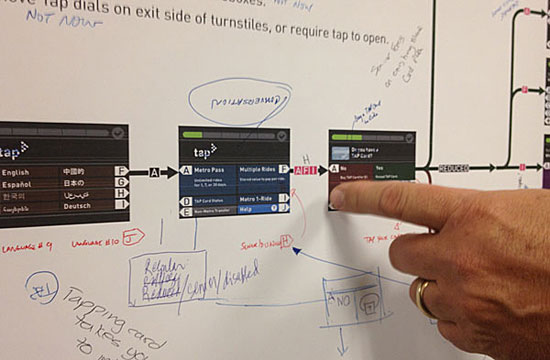
Sutton and his team are going back to the drawing board to create more intuitive vending machine screens.
Posted 1/30/12
Expo work keeps on rolling
November 16, 2012
Construction on the second phase of the Expo Line will continue moving ahead while a legal appeal of the project’s environmental process is pending, the California Supreme Court ruled this week.
The homeowners group Neighbors for Smart Rail had asked the state’s high court to halt work on the light rail line until its appeal could be decided. The group’s lawsuit challenging the project’s environmental review previously has been rejected at both the state trial and appellate court levels.
The initial segment of the Expo Line is now running between downtown L.A. and Culver City and is attracting record numbers of riders. Construction on the $1.5 billion second phase of the line, which will run to Santa Monica, is now underway.
“This decision preserves thousands of direct and indirect jobs just when our local economy is slowly starting to recover,” said Supervisor Zev Yaroslavsky, who also serves as chairman of the Expo board. “At the same time, it keeps our efforts to build a modern transit system on-track.”
Earlier, Yaroslavsky and other officials had expressed deep concerns about the potential of a court-ordered delay in construction, which they said would not only eliminate jobs but also contribute to costly delays.
When completed in 2015, the Expo Line, paralleling the heavily congested 10 Freeway, is expected to make it possible to travel between downtown L.A. and Colorado Avenue and 4th Street in Santa Monica in 46 minutes.
Posted 11/16/12
What’s on TAP? For some, confusion
September 13, 2012
All Brandon Crosby wanted was to hop aboard the Red Line subway and travel one stop—from Hollywood/Highland to Hollywood/Vine—to get to the box office at the Pantages Theatre.
But for Crosby, the journey of a single stop began with a thousand questions.
Standing at a bank of Metro ticket vending machines Tuesday afternoon, Crosby was flummoxed and increasingly exasperated as he tried to figure out how to buy a ticket to get him to the theater and back. The machine was offering him no choice but to buy something he didn’t see why he needed—a $1 plastic TAP card—along with his regular fare. And where was the round trip option? Then, when he pushed the “help” button, he got even more confused when the machine told him that his preferred purchase—a paper ticket for one-time use—was available, when in fact it was not.
“It makes no sense to me,” said Crosby, an L.A. resident who usually drives but wanted to give the subway a try for what he thought would be a quick jaunt. “I hate it.”
He’s not alone. While thousands of regular and occasional Metro train riders seem to be adapting well to the agency’s new, mandatory TAP card system that’s rolling out this summer, first-timers, tourists and people who haven’t ridden Metro trains lately are encountering trouble on the tracks. Some seniors are complaining, too, about having a hard time finding the reduced-fare options on the ticket machines’ new menu of purchase alternatives.
David Sutton, Metro’s director of TAP operations, is sympathetic to their concerns. But given the magnitude and complexity of the changeover to the loadable fare cards, he believes the transition is going well overall.
Already, some 400,000 to 500,000 TAP cards are in active use. Nine of the region’s municipal bus lines, along with the city of Los Angeles’ DASH and Commuter Express buses, are now part of the program (although cash is still being accepted on buses system-wide.)
The complete range of Metro passes has now been integrated into the TAP program, and efforts are underway to do the same with Metrolink and EZ Transit passes as well.
Metro’s changeover to TAP has been in the planning and testing phases for years. It’s a necessary precursor to another longstanding goal: locking the turnstiles at Metro stations so fare-beaters finally will be forced to pay their fair share.
That objective makes it all worthwhile, said George Ortiz, a regular rider who’s studying to be a sound engineer in Hollywood.
“It’s actually pretty good that they did it,” Ortiz said. “I would see people get on the Metro without paying.”
And once riders figure out how to get that initial TAP card—or, on a more basic level, understand what a TAP card is and why they need to buy one—many seem at peace with the process.
“It wasn’t bad except for the very first part I was confused, because I didn’t know what a TAP card was,” said Randy Riggs, visiting from Las Vegas. “The rest of it was pretty easy.”
“It’s actually not bad. It was just confusing at first,” added Prentice Deadrick Jr., a student who commutes regularly from the San Gabriel Valley to school in Hollywood. It doesn’t help, he said, that the ticket machine changeover is being staggered—so that riders can still buy paper tickets at one station but can only purchase TAP cards at others. (The timetable for converting the remaining machines is here, including Orange Line stations from September 6-12 and Union Station from September 17-20.)
“They should have done it all at one time, instead of some spots have paper, some spots have TAP,” Deadrick said.
Sue Bromley, a tourist from Australia who was heading to the Dodgers game with her husband, suggested that it would help to have a ticket agent on hand to explain things.
Back home in Sydney, she said, public transit riders buy paper tickets from machines, “but we still have people at the ticket office as well.”
As each station’s ticket machines are converted, Metro assigns field representatives to assist travelers for the first couple of days. But then they move on, leaving confounded would-be ticket-buyers on their own.
At the Hollywood & Highland station Tuesday afternoon, first-time users looked in vain for somebody—anybody—to show them the ropes.
Some gave up. Others got assistance from passing commuters, a writer for Supervisor Yaroslavsky’s website, even a panhandler who was working the crowd for small change.
(For the record, their questions went well beyond the operation of the ticket machines. They also wanted to know what time the trains stop running, whether day passes were good for a calendar day or for 24 hours, and the best place to get a good view of the Hollywood sign.)
Even with the impromptu help, some walked away shaking their heads. “It’s too complicated to see how it works,” said Sabine Pflipsen, who was visiting from Germany. “If you just want to have a ticket, you have to buy a plastic card. Why can’t I take a ticket for $1.50 and it’s done? I need to get this plastic thing? And it’s not explained in my traveling booklets.”
Gail Harvey, Metro’s director of customer relations, said she rarely hears from tourists like Pflipsen but is getting an earful from seniors these days.
Her staff receives some 20 complaints a day about the TAP changeover, virtually all of them from seniors having difficulties purchasing their customary reduced fares on the reformatted machines.
Typical comments range from “I missed it” to “Why don’t we have paper anymore?”
Sutton, director of TAP operations for the past year, feels their pain.
“It’s daunting when you first face one of our machines. People are used to more intuitive technology these days,” he said, such as touch screen machines being tested in other markets.
For now, he said, Metro is working as fast as it can to finish updating ticket machines at all the stations by September 20 and fixing glitches like the contradictory information that’s still on the machines’ “help” screens.
There’s no money in the budget to place workers permanently at stations to answer travelers’ questions, he said, but new signs are being printed and affixed to the machines.
Eventually, he predicted, buying and using TAP cards will become second nature to the traveling public.
“Change is hard for everybody and a lot of folks are used to buying paper tickets,” he said. “When ATMs came out, my dad said he would never use one. Eventually, he converted.”
Posted 9/6/12
Expo, Orange Line ridership on a roll
August 16, 2012
Metro’s new transit lines are taking Los Angeles for a ride—in a big way.
The Expo Line, which opened April 28, has seen its ridership rise dramatically over the course of the past three months. The light rail line, which had 320,627 boardings in May, gave passengers 497,449 rides in July—an increase of 55%. Ridership on the line rose across the board—on Saturdays, Sundays and weekdays. Weekday ridership was up more than 60%, with 18,181 boardings last month, compared to 11,347 in May.
The surge is welcome news for the Expo Construction Authority, which built phase one of the project and is now at work on the line’s second and final leg to Santa Monica.
“We fully anticipate that ridership will continue to increase in the fall when school starts again and people realize there is a viable alternative to the congested I-10 freeway,” said Samantha Bricker, Expo’s chief operating officer.
It’s typical for new transit lines to get off to a slow start—but not this time.
“It’s very surprising,” said Metro’s chief operations officer, Frank Alejandro. “The Blue Line [ridership] jumped pretty quickly, but not as quickly as this.”
Part of the increase was spurred by the opening of two new stations—Farmdale and Culver City—in June, after the initial part of the line was already operating. In addition, some bus routes also were reconfigured to make it easier for commuters to transfer to the new line. And, in an unexpected but welcome development, the Daily News reported last month that many San Fernando Valley residents are taking the Red Line to downtown Los Angeles in order to pick up the Expo Line and travel to points west.
One of the newest riders is Hannah Burnham, who was starting a new job at USC as props master for its theater department Thursday and was taking her first ride on Expo to get to work. She had driven from Burbank to North Hollywood, where she picked up the Red Line to the 7th/Metro station and hopped aboard the Expo Line.
“I think it’s going to be great because I do not want to drive from Burbank to down here,” Burnham said. “Plus the pass is less than a parking permit at USC, plus USC will pay almost 40% of your Metro pass per month.”
In the San Fernando Valley, meanwhile, Orange Line ridership also reached new highs. The rapid transit busway, which on June 30 opened a new four-mile northward extension from Warner Center to Chatsworth, posted its best-ever Saturday ridership in July. The total of 16,999 Saturday boardings beats the previous record of 15,629 set in June, 2008.
Metro officials said 12% of the increase was directly attributable to the new extension. The ridership figures include only paid boardings. Thousands more rode for free on the line’s gala opening.
Even before the extension opened, the Orange Line’s ridership was surging. Boardings for the year ending June 30 were the highest ever on the nearly 7-year-old busway. More than 7.8 million trips were taken on the Orange Line; the previous annual record was 7.45 million boardings in 2008.
Of course, the Orange Line has been an overachiever since Day One, beating ridership projections its first month out, in November, 2005.
“Ridership out here in the Valley is tremendous,” said Karla Aleman, assistant transportation operations manager for Metro in the West Valley. “It’s amazing. A lot of people here depend on public transportation.”
Posted 8/16/12
Trains for night owls
July 24, 2012
Heading out to experience L.A.’s famous nightlife? Here’s a new reason to celebrate: Metro is extending rail service until 2 a.m. on Friday and Saturday nights.
Currently, final trains leave between midnight and 1 a.m., depending on the station and rail line. Starting July 27, the last trains on all rail lines will not depart until 2 a.m., and the last Orange Line bus won’t depart from North Hollywood until 2:40 a.m. to accommodate transfers from the Red Line. Trains will run every 20 minutes during the new hours to destinations like Hollywood, downtown L.A., Pasadena and Long Beach.
The service expansion should be a boon for people who work or play into the wee hours, and need a way home that doesn’t involve driving or hailing a cab.
Lt. Ron Katona, the officer in charge of traffic coordination for the Los Angeles Police Department, says the new service provides another way for revelers to get home safely.
“As far as drinking is concerned, we always recommend using a designated driver or taking public transportation instead of driving,” said Katona. “This will give people another option.”
Metro CEO Art Leahy said the move should help expand Los Angeles’ growing cadre of train riders.
“By extending our service hours we will attract more people, especially young people,” Leahy said.
Eventually, Leahy hopes to increase night service hours even further, bringing L.A. closer to the 24-hour service of cities like New York and Chicago in areas where the extended hours prove popular.
“This is a test to see how it works,” Leahy said. “We may keep it on some lines and drop it on others depending on how many people use it.”
The move’s already receiving good reviews.
“We win!!” exulted the Facebook fan page called “Keep The L.A. Metro Rail Open After-Hours,” which is pushing for even later hours.
A bartender at Blue Palms Brewhouse in Hollywood, who identified himself only as Bix, bets the late trains will be good for business.
“We have a lot of guests that come in from the Valley, so now they can stay longer,” he said.
Posted 7/18/12




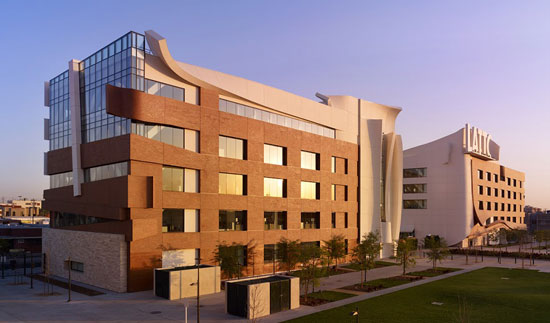

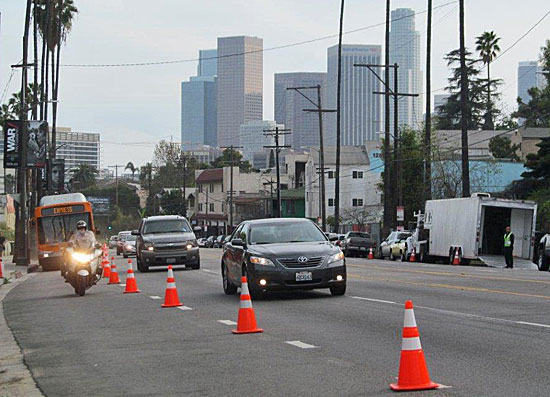
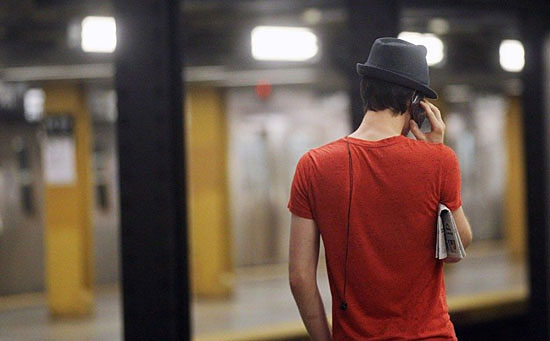
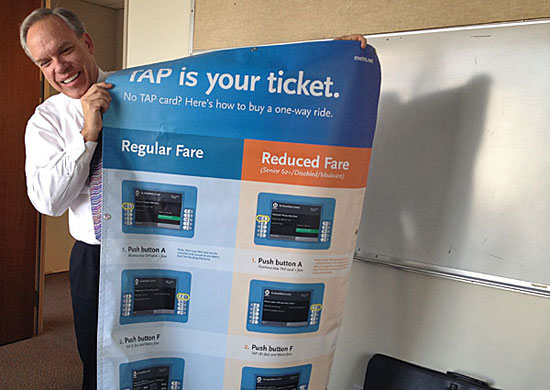
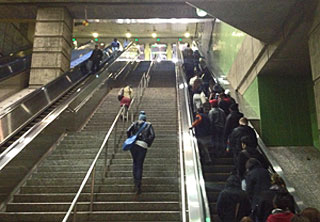
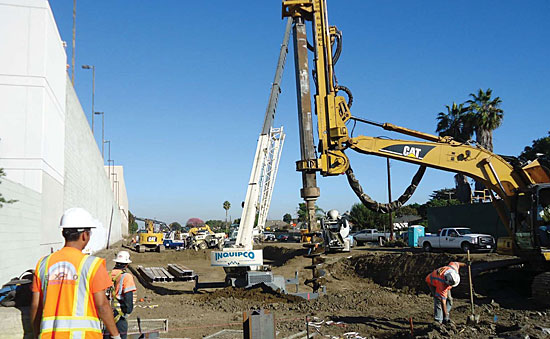
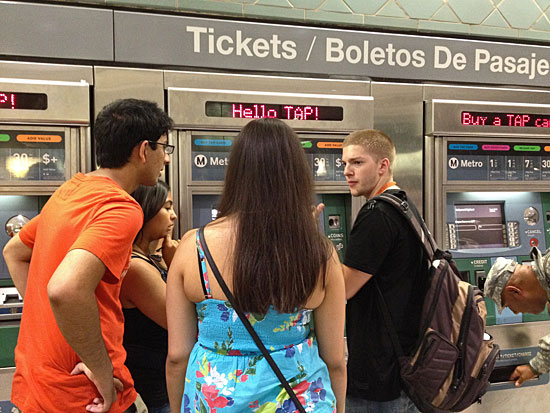
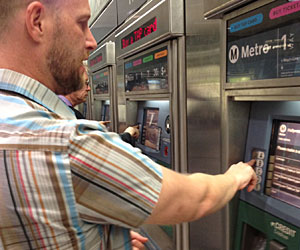
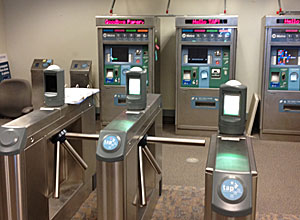
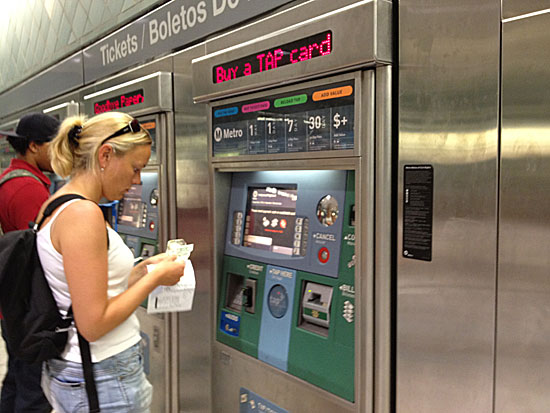
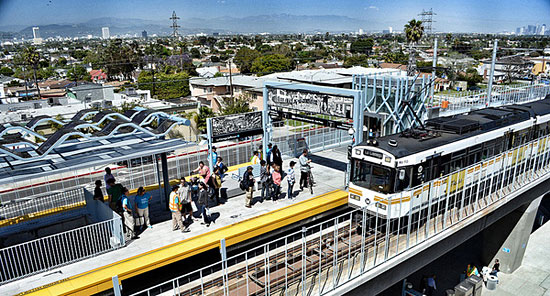
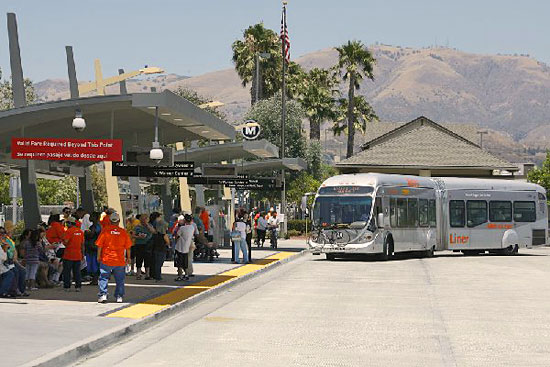
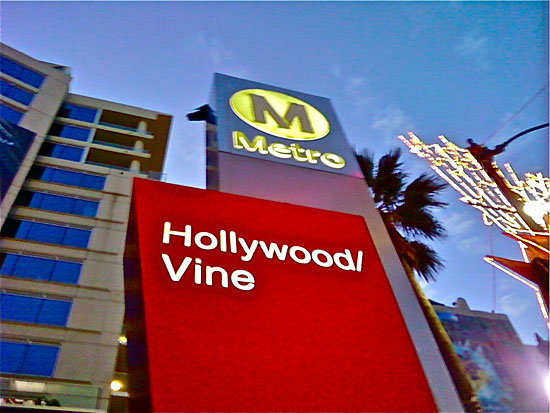







 405 bridge work causes a stink
405 bridge work causes a stink

